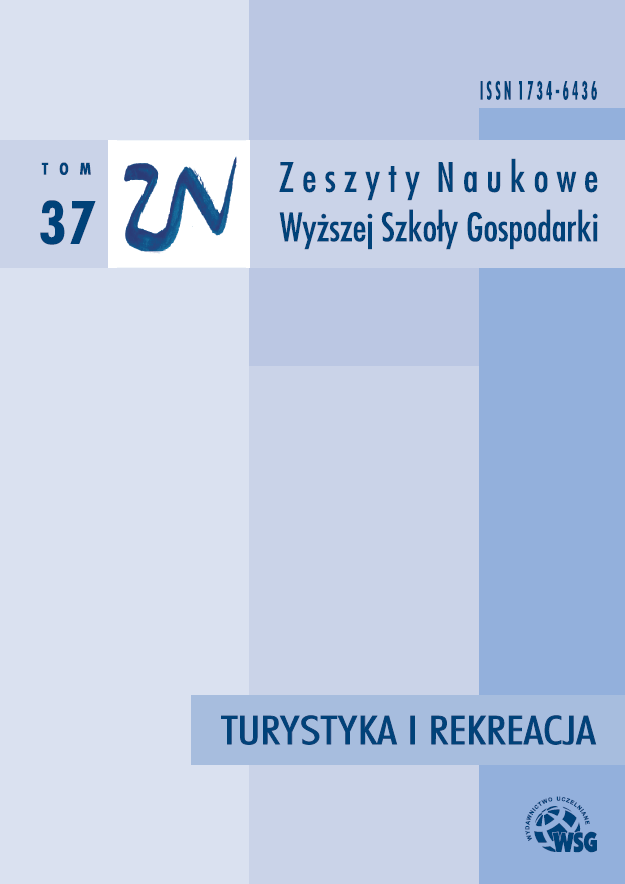Big-Data Analysis – is a new, better method of researching tourism service consumers in regions? Comparative analysis on the example of tourism research conducted in the Kujawsko-Pomorskie region?
Keywords:
tourism statistics, tourist traffic research, Big Data, tourist marketing, tourist demand research, tourist behavior, tourist traffic monitoringAbstract
Collecting tourism statistics is “necessary to measure the size, scale, impact and value of tourism at various geographic scales – from global to national to local destination” (Hall and Page 2014). BIG-Data sets in research on tourism demand, which, along with the growing computerization and the use of modern ICT (Information and Communications Technologies – ICT) technologies, in the field of empirical research on tourism seem to be one of the most current issues. In the article, using the example of tourism research conducted in the Kujawsko-Pomorskie region, the authors compared standard and BIG-Data based research procedures and assessed the usefulness of this type of data. An attempt was made to answer the following question – can the scientific data obtained from the BIGData collections be able to effectively compete with the data on tourism demand obtained in classic research (conducted mainly with the use of survey and survey methods)? Despite some methodological doubts and the identification of gaps in the compared results, it can be assumed that the analysis of data on tourism demand from the so-called “data clouds” should become a permanent feature of regional tourism research. However, the extension of the catalog of methods and data used in research on tourist services consumers to include BIG-Data data analysis should be associated with the adoption of certain assumptions. In the current market realities, the analysis of BIG-Data should primarily be complementary, and therefore one should not depart from classical research (because they still bring a lot of cognitive value). As a result, the results obtained in this way could cover a much larger fragment of the research field than before and at the same time broaden the cognitive effects – which may bring much greater benefits when this knowledge is applied in practice.
Citation_______________________________________________________________________________
Jaroszewska-Brudnicka, R., Brudnicki, R., Śpiewak, R. (2021). Big Data Analysis – nowa, lepsza metoda badań konsumentów usług turystycznych w regionach? Analiza porównawcza na przykładzie badań ruchu turystycznego prowadzonych w regionie kujawsko-pomorskim, Zeszyty Naukowe Wyższej Szkoły Gospodarki - Turystyka i Rekreacja, t. 37, nr 16, Wydawnictwo Uczelniane WSG, Bydgoszcz, s. 123-137. https://ojs.byd.pl/index.php/tir/article/view/17/3
_______________________________________________________________________________________
References
Alejziak W., 2010, Aktualny stan badań konsumentów usług turystycznych w regionach, [w:] E. Dziedzic (red.), Regionalne badania ruchu turystycznego i konsumpcji usług turystycznych w Polsce, POT, Warszawa [online] https://www.pot.gov.pl [data dostępu: 15.05.2022].
Brudnicki R., 2005, Kierunki i metody badań ruchu turystycznego, Seria „Turystyka i Rekreacja”, nr 5, WSG, Bydgoszcz.
Dziedzic T., 2013, Funkcje i użyteczność pomiarów ruchu turystycznego, „Problemy Turystyki i Rekreacji”, 2013 (4), SGTIR, Warszawa.
Hall C.M., Page S., 2014, The geography of tourism and recreation: Environment, place and space (4th ed.), Routledge, New York [online] https://www.taylorfrancis.com [data dostępu: 15.05.2022].
Kachniewska M., 2014, Big Data Analysis jako źródło przewagi konkurencyjnej przedsiębiorstw i regionów turystycznych [online] https://cor.sgh.waw.pl [data dostępu: 15.05.2022].
Majewska J., Napierała T., Adamiak M., 2016, Wykorzystanie nowych technologii i informacji do opisu przestrzeni turystycznej, „Folia Turistica”, nr 41, s. 309-340, Kraków [online] http://yadda.icm.edu.pl [data dostępu: 15.05.2022].
Matczak A., 1992, Model badania ruchu turystycznego. Studium metodologiczne, Acta Universitatis Lodziensis, Wyd. UŁ, Łódź.
Nam H., Kannan P.K., 2014, Informational Value of Social Tagging Networks, “Journal of Marketing”, 78 (4) [online] https://www.researchgate.net [data dostępu: 15.05.2022].
O’Neil C., 2017, Broń matematycznej zagłady – jak algorytmy zwiększają nierówności i zagrażają demokracji, Wydawnictwo Naukowe PWN, Warszawa.
Ryśnik J., Żylak D., Gibas P., 2019, Tradycyjne ankietowanie vs. wykorzystanie Big Data danych geolokalizacyjnych – analiza porównawcza na przykładzie badań turystów-kibiców sportowych uczestniczących w ME U21 2017 w Tychach, „Folia Turistica”, nr 53, Kraków [online] http://www.folia-turistica.pl [data dostępu: 15.05.2022].
Saluveer E., Raun J. i in., 2020, Methodological framework for producing national tourism statistics from mobile positioning data, “Annals of Tourism Research”, Vol. 81, March 2020, 102895, [online] https://www.sciencedirect.com [data dostępu: 15.05.2022].
Śledziewska K., Włoch R., 2021, Gospodarka cyfrowa – jak technologie zmieniają świat, Wydawnictwo Uniwersytetu Warszawskiego, Warszawa [online] https://www.delab.uw.edu.pl [data dostępu: 15.05.2022].
Włodarczyk B. (red.), 2011, Ruch turystyczny w Łodzi i województwie łódzkim w roku 2011, Wyd. ROTWŁ i IGMiTUŁ, Łódź.
Woźniczka J., 2018, Big Data i ich wykorzystanie w analityce marketingowej.
Wybrane problemy badawcze, „Marketing i Rynek”, 3/2018 [online] https://www.researchgate.net [data dostępu: 15.05.2022].
Zhan Y., Hua Tan K., Ji G., Chung L., Tseng M., 2021, A Big Data Framework for Facilitating Product Innovation Processes, “Business Process Management Journal”, 23 (3) [online] https://sm.xmu.edu.cn [data dostępu: 15.05.2021].


